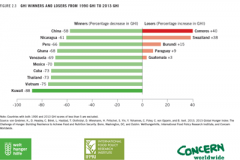About one in eight people worldwide suffered from chronic hunger during the past two years, according to the United Nations. Though daunting, that ratio is an improvement over previous years. In fact, the 2013 Global Hunger Index report released today shows that global hunger levels have declined by nearly 35 percent since 1990.
The Global Hunger Index (GHI)—a tool that quantifies food insecurity and tracks its rise or decline—is calculated annually and released in a report published by the International Food Policy Research Institute (IFPRI),Welthungerhilfe, and Concern Worldwide. Based on the most recent available data, the index gives countries and regions a “score” composed of three equally weighted indicators—undernourishment, child underweight, and child mortality—that represent hunger in different ways.
Hunger Rises
Worldwide, the GHI score has been dropping, indicating an overall decline in hunger levels. Nonetheless, the world GHI is still classified as “serious,” and 19 countries have hunger levels classified as “alarming” or “extremely alarming.” Five countries have seen their GHI scores rise since 1990; the three most drastic spikes occurred in Africa south of the Sahara.
- Comoros. After nearly a decade of political violence and subsequent poverty, the Comoros islands began to see improvements in 2000, indicated by a declining GHI score. However, this success plateaued in 2005.
- Swaziland. The HIV/AIDS epidemic and income inequality are primarily responsible for severely undermining food security in Swaziland. In 2011, an estimated 26 percent of adults in the country had HIV—the highest prevalence of the virus in the world. Despite achieving sizable reductions in child mortality and mother-to-child transmission of HIV, Swaziland saw its GHI score continue to rise owing to years of extreme drought.
- Burundi. Rising hunger levels in Burundi can be attributed to prolonged conflict and political instability. Despite a transition to peace in 2003, the country still has one of the highest proportions of underweight children in Africa.
Paraguay and Guatemala also saw considerable increases in their GHI scores between 1990 and 2013.
Hunger Falls
On the flip side, 90 countries have reduced their GHI scores since 1990—23 of them by 50 percent or more, representing a notable drop in chronic hunger. The three top performers (those with the greatest declines in hunger since 1990) are Kuwait, Vietnam, and Thailand.
- Kuwait. Because of the Iraqi invasion, Kuwait had an unusually high GHI score in 1990, but by 1995 its score fell by more than 59 percent. Since then its GHI score has continued to decline, but less dramatically.
- Vietnam. Vietnam’s impressive progress in reducing hunger can be attributed to both broad-based economic growth and a national commitment to nutrition. These efforts resulted in a 35 percent drop in the proportion of undernourished people, a 28 percent drop in child underweight between 1990 and 2011, and a reduction of more than 50 percent in the under-five mortality rate.
- Thailand. Thailand has reduced its GHI score by almost 75 percent since 1990. Childhood nutrition has long been a priority in Thailand, where as early as the 1980s the government integrated community-driven nutrition programs into its National Economic and Social Development Plan.
GHI scores in China, Cuba, Ghana, Mexico, Nicaragua, Peru, and Venezuela have also declined greatly since 1990. Ghana is particularly noteworthy as the only country from Africa south of the Sahara on the list of top performers.







